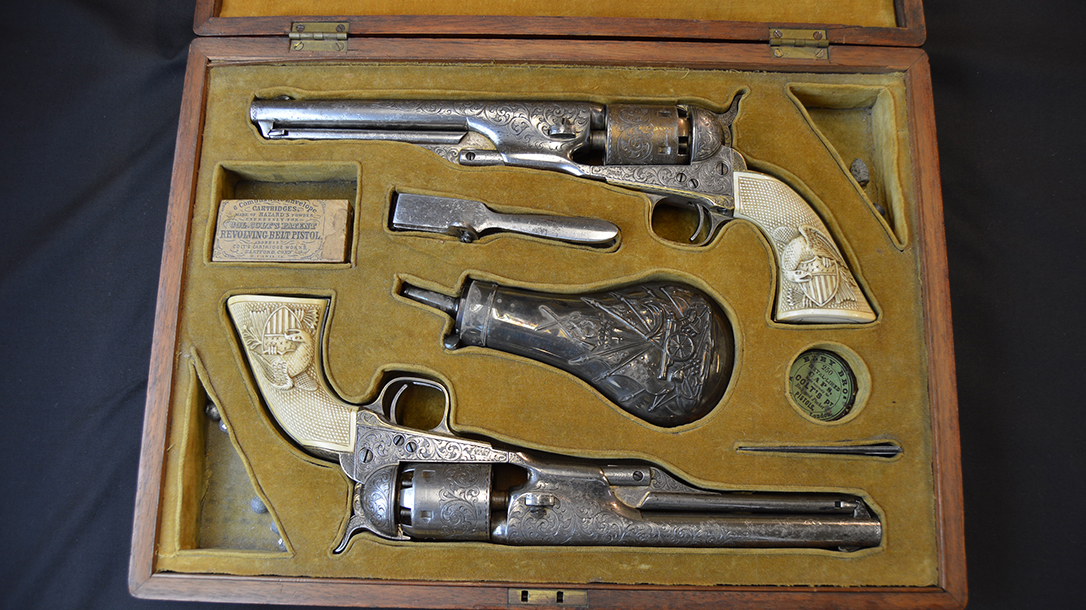The Frazier History Museum in Louisville, Kentucky, exhibits a remarkable collection of famous Western firearms. This includes a cased pair of heavily engraved, gold- and silver-plated, elephant-ivory-gripped, .36-caliber Colt Model 1861 Navy revolvers believed to be owned by Lieutenant Colonel George Armstrong Custer. A marshal superstar in his time, Custer is remembered today mostly for dying at the Battle of Little Big Horn in 1876 with all 210 cavalrymen from the five companies he kept under his direct command.
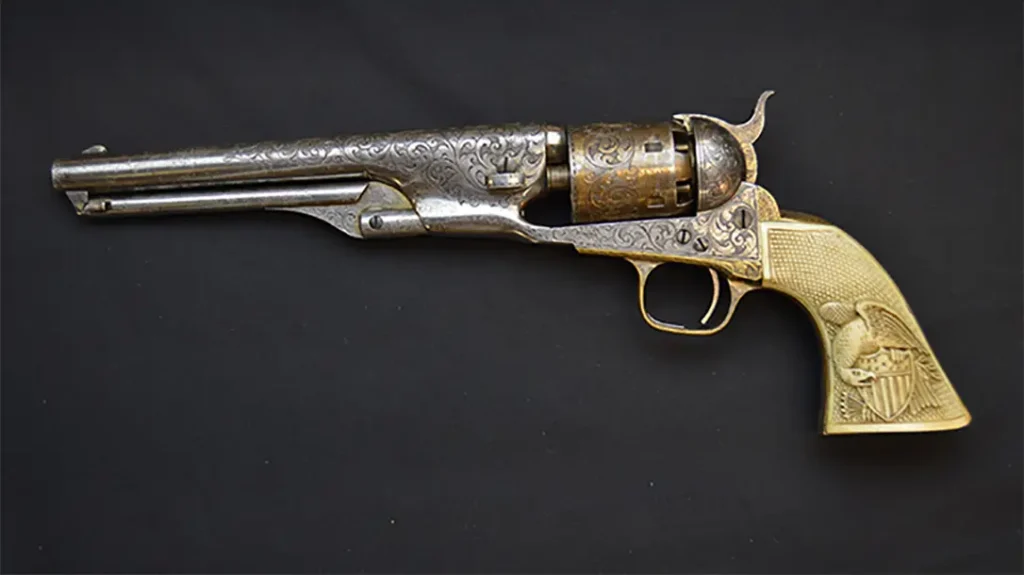
Custer Colts
On that bloody day, Custer’s 7th Cavalry was vastly outnumbered, probably in the range of four to one, by a combined force of Lakota, Northern Cheyenne and Arapaho Indians. Many outside of Custer’s battalion survived the battle, which was more complex than most people realize. But for the Plains Indians, it was a great victory. For the U.S. Army, it was the worst defeat of the 18th century Indian Wars campaign. When the news of the massacre broke, it sent an immediate shockwave across America.
Advertisement — Continue Reading Below
At the time of his death, Custer was a national hero. During the Civil War, he was nicknamed “The Boy General”. This was after he was promoted to brigadier general on June 29, 1863, at age 23. He was one of the youngest men of that rank in the Union Army. Collector lore says these revolvers were a gift to the young Custer on the occasion of this brevet promotion to general. However, we can only speculate who they came from because the dedication plates are no longer on the grips.
Custer cultivated a heroic image for himself with custom uniforms. He also had upscale personal weapons and his signature long, curly blond hair that he sometimes scented with cinnamon. But mainly it was his dashing battlefield victories that won him fame and respect. He was an extremely aggressive and courageous commander, and he led his troops from the front. He was in many respects a 19th century General George S. Patton, though considerably less learned and disciplined. Like Patton, Custer was also an avid hunter, shooter and gun collector. Patton’s ivory-gripped, engraved Colt Model 1873 six-shooter became an icon. But that was not the case with Custer’s brace of ivory-gripped, engraved 1861 Navy Colts.
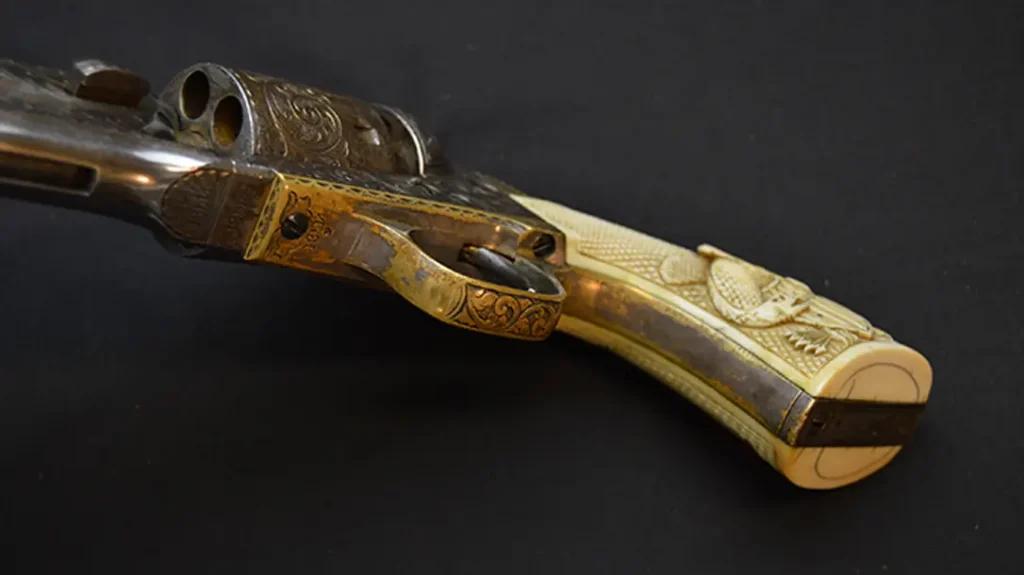
Advertisement — Continue Reading Below
Beautiful Colt Model 1861 Revolvers
Before I examined these magnificent Colt Model 1861 revolvers, I had always assumed them coffee-table trophies that never left his quarters. But they are masterpieces. To me, shooting them would be like using King Tut’s gold death mask for a Halloween costume. After I had a chance to study the Colts up close, it was apparent that both revolvers had some damage from pitting and significant finish wear. They were cleaned up and returned to a high polish at some point in their history. However, they were not re-plated. To me, this clue suggests that these pistols were carried and shot. Patton shot his engraved Colt extensively. Wouldn’t the flamboyant and daredevil young Custer have done the same?
It is possible, and perhaps even likely, that the pitting on these pistols is the result of some poor storage in the 137 years before they made their way to Frazier Museum. That is a harder case to make in regards to the wear on the gold finish and grips. It is feasible that the pistols were handled by so many Custer admirers over the years that they simply “loved” the gold plating off of the backstraps; triggerguards; hammers; cylinders; and loading levers. Those admiring hands could have also worn down the high spots on the grips.
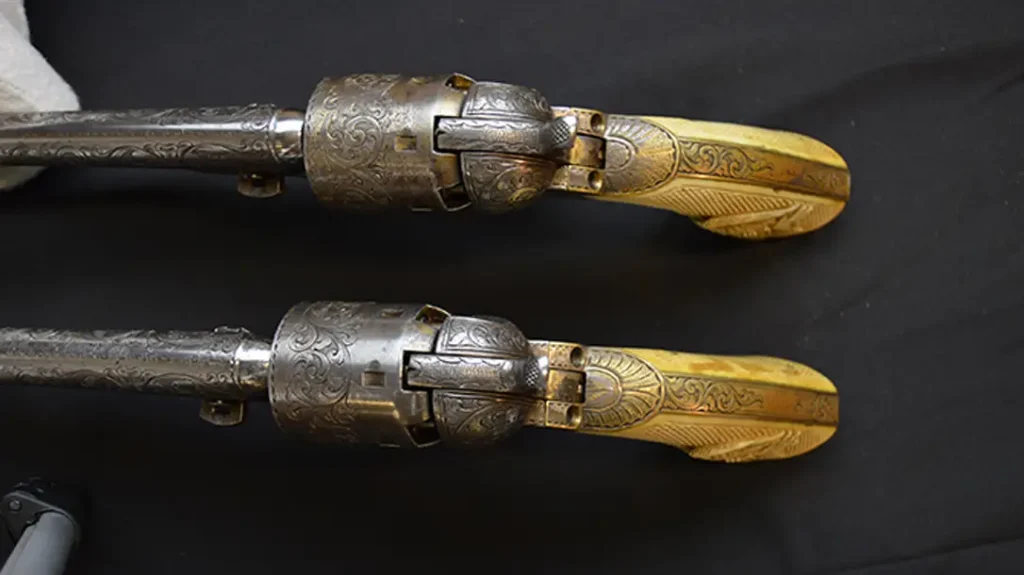
Advertisement — Continue Reading Below
There’s no way to tell how much an impact handling may have had on these revolvers. We would have to research the habits of the individual collectors that owned them before. Once in the Frazier collection, however, they were cared for in the manner artifacts should be. Whatever minimal handling they experienced was undertaken with gloved hands.
Speculation
There is another explanation, perhaps complimentary, of the wear on these pistols that is worth considering. It’s also a lot more fun. If they were used by a cavalryman actively campaigning for a year in the Civil War, they would be carried in leather holsters. Leather holsters absorb humidity from the air, and rain for that matter, and can rust the pistol stored inside. The snug-fitting flap holsters in common military use at this time could easily cause some finish and grip wear. Actually shooting the pistol will tend to wear the plating off the trigger finger area and the front- and backstraps. The heat of shooting and the handling necessary to load the revolver could lead to plating loss on the cylinder. The loading lever would also logically show a lot of plating loss since it is handled every time a cap-and-ball revolver is loaded.
I suggest that Custer was just the type of man to actually carry and use presentation-grade firearms. There is an 1874 photograph of Custer and his wife, Libby, in his study in their quarters at Fort Lincoln in the Dakota Territory that shows his gun rack in the corner. The cap-and-ball Colt 1861 Navy revolvers aren’t visible in the gun rack in that photo. But why would we expect them to be? By 1874, the metallic cartridge was pushing cap-and-ball pistols into obsolescence with nobody lamenting the change.
Advertisement — Continue Reading Below
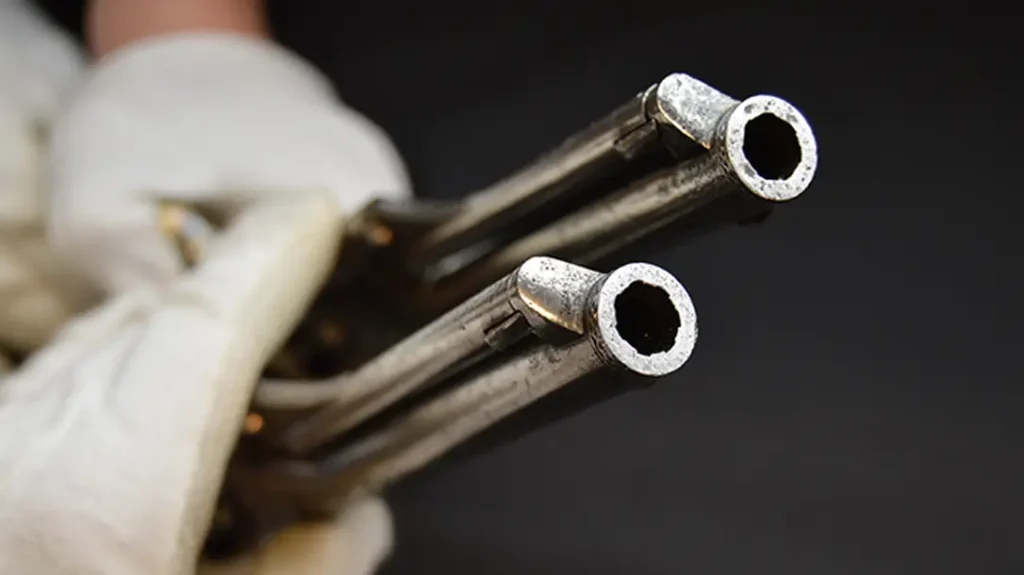
Digging Deeper
The brace of revolvers we can see in that gun rack appear to be plated S&W Model 2 revolvers. I see this as significant because, in 1869, Custer received a beautiful cased pair of .32-caliber S&W Model 2 revolvers, acid-etched with floral designs, silver plated and stocked with mother-of-pearl grips from his admirer, business tycoon John B. Sutherland. Assuming the pair of pistols in the rack are the same, and assuming they are in the rack rather than their fitted case because Custer shot them, why wouldn’t he have shot his Colt Model 1861s, too?
The nearly identical American scrollwork that covers virtually ever surface of each pistol was presumed to be the work of master engraver L.D. Nimschke. There is no record to support this, but the style and execution strongly suggest it. The hand-carved, high-relief patriotic eagle and shield grips may have been provided by the Colt factory. I could find no shipping information from the Colt factory in the museum’s records. However, the serial numbers of these pistols (“13511 P” and “13514 P”) put them among a group of Navy Colts made in 1863 and specially polished and set aside for embellishment.
Advertisement — Continue Reading Below
Comparison
It is believed the “P” indicated at that time that the pistols were highly polished. The cylinders of these pistols seems to have been left free of the usual roll-engraved battle scene. However, the parallel lines that frame a border around the serial number are clearly evident on the cylinder of revolver #13514.
Of the two revolvers, #13514 is in significantly better cosmetic condition. Revolver #13511 has a lot more pitting on the barrel. The gold plating in the triggerguard area and inner grip frame is more worn. Its cylinder is virtually devoid of gold plating. It also seems to have more grip wear on the high points of the eagle’s talon below the shield and his outward wing. This makes me wonder if #13511 was fired more than its mate. Both pistols have good barrels with crisp rifling. If they were shot, their barrels were well cleaned.
The accessories fitted into the velvet-lined case, as well as the case itself, are in very good condition with little damage. I didn’t detect obvious signs of serious moisture damage to the case or accoutrements. The bullets had the usual light white corrosion one finds on old bullets. The silver-plated powder flask was tarnished and showed some light discoloration. The paper cartridge boxes and metal cap tin appeared to be in excellent condition. The set also includes a nipple wrench and a silver-plated dual bullet mold that matches the bullets in the set. The key to the case lock was lost long before it got to the Frazier History Museum.
Advertisement — Continue Reading Below
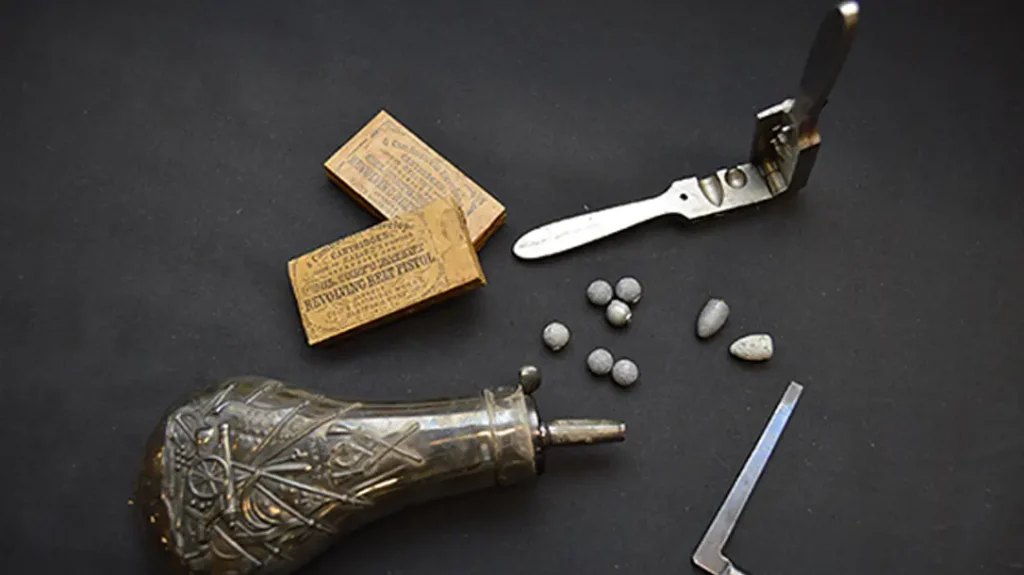
Colt Model 1861 – A Curious Path
Readers will notice that the right side of each grip frame was smoothed down. In addition, holes were made for mounting a dedication plaque. Because these reportedly gold plaques are missing, exactly who gave these exceptional (and expensive) revolvers to Custer is lost to history. Collector lore says they were absent from the grips when the revolvers were sold. They are reportedly removed by Custer’s wife to keep as mementos. Their location remains unknown. Secondary records in the museum files suggest the plaques were removed to avoid embarrassment to the family at having to sell such an important ancestral heirloom. Knowing how Custer’s wife dedicated the rest of her life to protecting her husband’s reputation, this is at least as plausible as them being stolen or lost. However, secondary sources suggest that Libby Custer was in good financial shape thanks to the publication of her books.
Unfortunately, the museum’s files had no originating documentary provenance for the pistols. I could find no bill of sale from the family to the original buyer, nor any indication of the exact date the transfer took place. Without the plaques to authenticate Custer’s ownership, we are left only with a long trail of private collector provenance. Evidence suggests the first buyer, famed Philadelphia arms and accoutrements dealer W. Stokes Kirk, obtained the pistols in the early 1920s. He died on January 26, 1926. He was about seven years younger than Libby Custer, who lived in New York City at the time of her death in 1933.
Advertisement — Continue Reading Below
Shoddy Recordkeeping
Back in those days, and still quite often now, collectors commonly accepted verbal affirmations of a piece’s authenticity without collecting and recording documentary evidence supporting that stated provenance. The result is that all we have left today to go on when trying to authenticate an artifact’s provenance is what we can research in surviving records and our impressions of the personal integrity of the parties involved.
When I was the director of the Patton Museum of Cavalry and Armor in Fort Knox, Kentucky, I was astonished to learn we had no documentation of any kind positively linking the 1938 Cadillac sedan on display in the museum for half a century to General Patton. Fortunately, Patton’s driver, Woody Woodring, was still alive at the time. I was able to get his personal assurance that it was in fact the car he was driving at the time of the accident that led to the General’s death. That sort of thing doesn’t happen with Civil-War-era firearms these days.
Colt Model 1861-The Truth Is Out There
I suggest that circumstantial and documentary evidence on the provenance of the Custer Colts may still be out there for someone willing to take a closer look. A fruitful area of research might start with an examination of the respective lives of Libby Custer and W. Stokes Kirk (a Bannerman protégé of sorts) and the extent of their relationship with each other. For example, were they friends? Naturally, I really hope the dedication plaques show up one day. Imagine the excitement of checking to see if the holes in them line up with the nail holes in the ivory grips. Every time I go to an online auction site, I can’t resist a “Custer gold plaque” search.
Advertisement — Continue Reading Below
